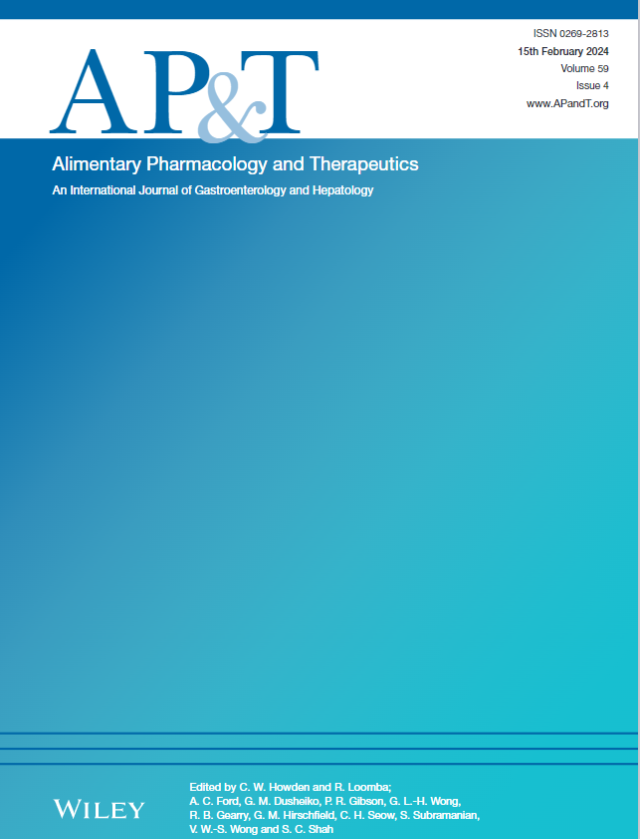Diagnostics of Autoimmune Hepatitis Enabled by Non-Invasive Clinical Proteomics.
IF 6.7
1区 医学
Q1 GASTROENTEROLOGY & HEPATOLOGY
引用次数: 0
Abstract
BACKGROUND Autoimmune hepatitis (AIH) may be difficult to diagnose and distinguish clinically and biochemically from other chronic liver diseases like metabolic dysfunction-associated steatotic liver disease (MASLD). AIMS To identify pathways involved in the pathogenesis and identify disease-specific biomarkers of AIH. METHODS We recruited 19 newly diagnosed patients with AIH, 17 with MASLD, and 19 healthy controls. Liver tissue and plasma were collected, and untargeted mass-spectrometry-based proteomics was performed. For classification of AIH versus MASLD and healthy, machine learning analyses were performed employing logistic regression models on liver and plasma proteome data. Findings were validated using data from the United Kingdom Biobank (UKB). RESULTS We identified 7632 liver and 556 plasma proteins with 2521 liver and 227 plasma proteins differing between AIH and healthy, including 56 overlapping. Metabolic dysregulation and systemic immune activation characterised the AIH liver and plasma proteome, respectively. Plasma proteome profiling enabled classification of AIH from MASLD and healthy with an area under the receiver operating characteristic curve of 0.91 (0.09 SD). Validation in the UKB was possible for 8 of 20 diagnostic proteins and showed consistent directional changes. Three proteins (C7, ICAM1, cAST) were significantly different between AIH and MASLD/healthy in unadjusted analyses, and 6 of 8 proteins (C7, ICAM1, cAST, IGFBP3, TIMP1, TTR) were significantly different when adjusting for age and sex. CONCLUSIONS Clinical proteomic analyses of paired liver-plasma samples from patients with AIH enabled high diagnostic potential. Proteomics may constitute a novel non-invasive diagnostic tool for AIH if validated in larger, age- and sex-matched cohorts. CLINICAL TRIAL NUMBER NCT05335603.非侵入性临床蛋白质组学诊断自身免疫性肝炎
背景:自身免疫性肝炎(AIH)可能难以从临床和生化角度诊断和区分其他慢性肝脏疾病,如代谢功能障碍相关脂肪变性肝病(MASLD)。目的确定AIH的发病机制和特异性生物标志物。方法我们招募了19例新诊断的AIH患者,17例MASLD患者和19例健康对照。收集肝组织和血浆,进行基于非靶向质谱的蛋白质组学。对于AIH、MASLD和健康的分类,采用肝脏和血浆蛋白质组数据的逻辑回归模型进行机器学习分析。使用英国生物银行(UKB)的数据验证了研究结果。结果共鉴定出7632个肝脏蛋白和556个血浆蛋白,其中2521个肝脏蛋白和227个血浆蛋白与健康人群存在差异,其中56个存在重叠。代谢失调和全身免疫激活分别是AIH肝脏和血浆蛋白质组的特征。血浆蛋白质组分析可将AIH分为MASLD和健康,受试者工作特征曲线下面积为0.91 (0.09 SD)。20种诊断蛋白中的8种可在UKB中进行验证,并显示出一致的方向变化。3个蛋白(C7、ICAM1、cAST)在AIH和MASLD/健康之间存在显著差异,8个蛋白中的6个(C7、ICAM1、cAST、IGFBP3、TIMP1、TTR)在调整年龄和性别后存在显著差异。结论对AIH患者的配对肝脏血浆样本进行临床蛋白质组学分析具有很高的诊断潜力。如果在更大的年龄和性别匹配的队列中得到验证,蛋白质组学可能构成一种新的非侵入性AIH诊断工具。临床试验编号05335603。
本文章由计算机程序翻译,如有差异,请以英文原文为准。
求助全文
约1分钟内获得全文
求助全文
来源期刊
CiteScore
15.60
自引率
7.90%
发文量
527
审稿时长
3-6 weeks
期刊介绍:
Alimentary Pharmacology & Therapeutics is a global pharmacology journal focused on the impact of drugs on the human gastrointestinal and hepato-biliary systems. It covers a diverse range of topics, often with immediate clinical relevance to its readership.

 求助内容:
求助内容: 应助结果提醒方式:
应助结果提醒方式:


